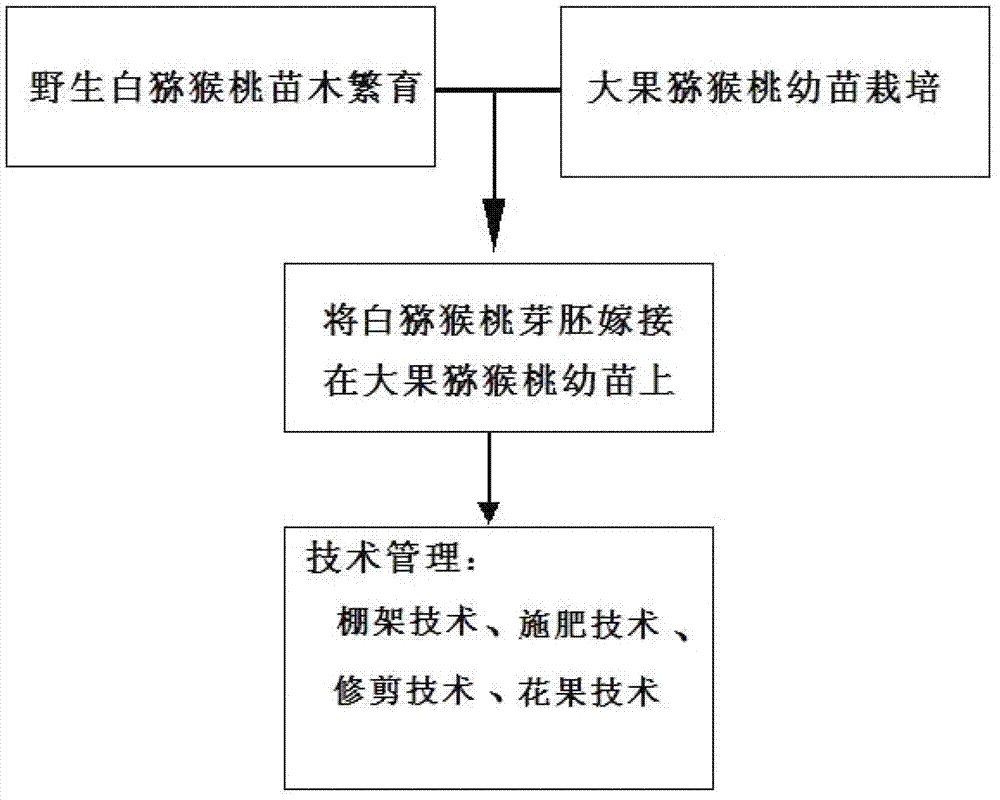White kiwi breeding and cultivating technology
A kind of kiwifruit technology, which is applied in the breeding and cultivation field of white kiwifruit, and can solve the problems of growing, breeding and transplanting wild white kiwifruit fruits, etc.
- Summary
- Abstract
- Description
- Claims
- Application Information
AI Technical Summary
Problems solved by technology
Method used
Image
Examples
Embodiment 1
[0017] (1) Breeding of wild white kiwifruit seedlings.
[0018] Wild white kiwifruit seedlings are bred by hard branch cuttings. Before pruning, cut the strong branches with a thickness of 0.8cm and full bud eyes into 20cm sections, and leave 2 nodes. Cut obliquely at the lower 2cm. Then tie it up, soak it in clean water for 6-9 hours, and then soak it in root powder and yellow mud for 1 hour to cut. The seedbed is paved with clean river sand to a thickness of 20 cm and disinfected with carbendazim. When cutting, first fill the seedbed with water, then spread a layer of plastic film close to the bed surface, insert the branches into the seedbed at a density of 15×15 cm, and leave 2 buds on the film. After inserting, set up an arch shed on the furrow and cover it with thick plastic film. When the seedbed is dry and cracked, the canopy film can be removed at noon on a sunny day to replenish the humidity, and the callus will be generated after 45 days. If the temperature grad...
Embodiment 2
[0037] (1) Breeding of wild white kiwifruit seedlings.
[0038] Wild white kiwifruit seedlings are bred by hard branch cuttings. Before pruning, the strong branches with a thickness of 1.2cm and full bud eyes are cut into 22cm sections, and 3 nodes are left. Cut obliquely at the lower 2cm. Then tie it up, soak it in clean water for 6-9 hours, and then soak it in root powder and yellow mud for 2 hours before cutting. The seedbed is paved with clean river sand to a thickness of 20 cm and disinfected with carbendazim. When cutting, first fill the seedbed with water, then spread a layer of plastic film close to the bed surface, insert the branches into the seedbed at a density of 15×15 cm, and leave 2 buds on the film. After inserting, set up an arch shed on the furrow and cover it with thick plastic film. When the seedbed is dry and cracked, the canopy film can be uncovered and sprayed with water at noon on a sunny day to supplement the humidity. Generally, the healing tissue ...
Embodiment 3
[0057] (1) Breeding of wild white kiwifruit seedlings.
[0058] Wild white kiwifruit seedlings are bred by hard branch cuttings. Before pruning, the strong branches with a thickness of 1.5cm and full bud eyes are cut into 25cm sections, and 4 nodes are left. Cut obliquely from 2cm below the joint. Then tie it up, soak it in clean water for 6-9 hours, and then soak it in root powder and yellow mud for 2 hours before cutting. The seedbed is paved with clean river sand to a thickness of 20 cm and disinfected with carbendazim. When cutting, first fill the seedbed with water, then spread a layer of plastic film close to the bed surface, insert the branches into the seedbed at a density of 15×15 cm, and leave 2 buds on the film. After inserting, set up an arch shed on the furrow and cover it with thick plastic film. When the seedbed is dry and cracked, the canopy film can be uncovered and sprayed with water at noon on a sunny day to supplement the humidity. Generally, the healing...
PUM
 Login to View More
Login to View More Abstract
Description
Claims
Application Information
 Login to View More
Login to View More - R&D
- Intellectual Property
- Life Sciences
- Materials
- Tech Scout
- Unparalleled Data Quality
- Higher Quality Content
- 60% Fewer Hallucinations
Browse by: Latest US Patents, China's latest patents, Technical Efficacy Thesaurus, Application Domain, Technology Topic, Popular Technical Reports.
© 2025 PatSnap. All rights reserved.Legal|Privacy policy|Modern Slavery Act Transparency Statement|Sitemap|About US| Contact US: help@patsnap.com

